1. PyQt5
# PyQt5安装
pip install PyQt5 -i http://mirrors.aliyun.com/pypi/simple/
# 安装PyQt5图形界面工具(designer)
pip install PyQt-tools -i http://mirrors.aliyun.com/pypi/simple/
1.1 PyQt5 常用模块介绍
PyQt5.QtWidgets: 控件元素集
PyQt5.QtCore: 核心非GUI功能, 处理涉及到的文件 目录 链接 线程等对象
PyQt5.QtGui: 图形处理 事件处理 字体文本
PyQt5.Network: 网络编程类,实现Tcp/Ip 及Udp协议
PyQt5.QtBluetooth:蓝牙活动类,涉及扫描设备 链接 数据流交互操作
2.窗口
2.1 种类:QWidget | QMainWindow | QDialog
from PyQt5.QtWidgets import QWidget, QLabel, QApplication
class Q(QWidget):
"""
QWidget:
窗口定义自由度高,
可自由扩展控件,
修改样式
"""
def __init__(self):
super(Q, self).__init__()
# 控件
l = QLabel('测试QWidget窗口', self)
l.setStyleSheet('color:green')
if __name__ == '__main__':
app = QApplication([])
w = Q()
w.show()
app.exec()
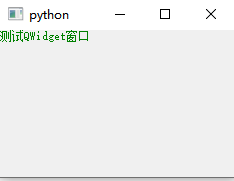
2.3 QMainWindow
from PyQt5.QtWidgets import QMainWindow, QApplication, QLabel, QMenuBar
class Q(QMainWindow):
def __init__(self):
"""
QMainWindow:
QWidget子类,添加了额外扩展
菜单栏QMenuBar
工具栏QToolBar
状态栏QStatusBar等
"""
super(Q, self).__init__()
self.init()
def init(self):
# 控件
l = QLabel('测试QMainWindow窗口') # 内容显示在主窗口区域
l.setStyleSheet('color:red') # 样式修改
l.setParent(self) # 添加控件到主窗口
# ps:菜单栏
m = QMenuBar()
# 一级菜单栏
fm = m.addMenu('文件')
m.addMenu('编辑')
m.addMenu('段落')
# 二级
fm.addAction('新建')
fm.addAction('打开')
fm.addAction('保存')
fm.addAction('另存为')
# 添加菜单栏
self.setMenuBar(m)
self.setCentralWidget(m)
if __name__ == '__main__':
app = QApplication([])
w = Q()
w.show()
app.exec()
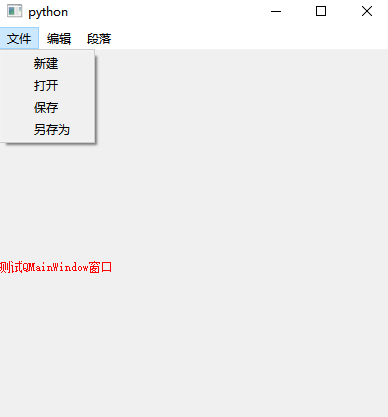
2.4 QDialog
import sys
from PyQt5.QtWidgets import *
class Q(QDialog):
def __init__(self):
"""
自定义对话框
不作为主窗口存在
多用于自定义信息提示
"""
super(Q, self).__init__()
l = QLabel('你好呀', self)
l.setGeometry(50, 50, 100, 30) # 设置绝对位置
class W(QWidget):
def __init__(self, d):
"""主窗口"""
super(W, self).__init__()
# 添加控件
bt = QPushButton('问候', self)
# 添加点击事件
bt.clicked.connect(self.click)
self.d = d
def click(self):
self.d.show()
if __name__ == '__main__':
app = QApplication(sys.argv)
d = Q()
w = W(d)
w.show()
# 程序进行循环等待状态
app.exec()
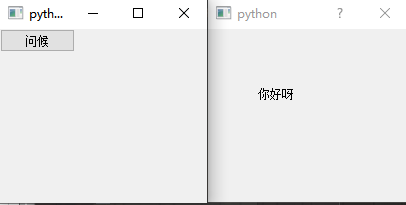
3.控件
3.2 常用控件
from PyQt5.QtWidgets import *
class Q(QWidget):
def __init__(self):
super(Q, self).__init__()
self.setWindowTitle('常用控件')
# 布局
f = QFormLayout(self)
# 控件
f.addRow(QLabel('纯文本&&链接&&图片标签'))
f.addRow(QLineEdit('单行输入框'))
f.addRow(QTextEdit('多行文本框'))
r1 = QRadioButton('好') # 单选
r2 = QRadioButton('不好')
b1 = QCheckBox('类型一') # 多选
b2 = QCheckBox('类型二')
b3 = QCheckBox('类型三')
f.addRow(r1)
f.addRow(r2)
f.addRow(b1)
f.addRow(b2)
f.addRow(b3)
f.addRow(QPushButton('按钮'))
if __name__ == '__main__':
app = QApplication([])
w = Q()
w.show()
app.exec()
3.3 自定义控件
# coding=utf8
from PyQt5.QtGui import *
from PyQt5.QtWidgets import *
class Clock(QWidget):
def __init__(self):
super(Clock, self).__init__()
self.resize(300, 300)
def paintEvent(self, QPaintEvent):
"""窗口控件初始化调用"""
# 画家
painter = QPainter(self)
# 画笔设置图画样式
# pen = QPen()
# pen.setColor(QColor(255, 255, 0))
# painter.setPen(pen)
# 作画
# 线段p1(x1, x2);p2(x2,y2)
# painter.drawLine(150, 10, 150, 280)
# 圆形(中心点x,y ; rx, ry)
# painter.drawEllipse(QPoint(150, 120), 30, 30)
# 多边形
# painter.drawConvexPolygon(QPoint(100, 100), QPoint(100, 150), QPoint(150, 100), QPoint(150, 200))
# 矩形(x,y,w,h)
# painter.drawRect(QRect(50, 50, 200, 50))
# 扇形(x,y,w,h,a,e)
painter.drawPie(10, 100, 200, 200, 300, 1500)
# 文本
# painter.drawText(150, 150, '文本测试')
if __name__ == '__main__':
app = QApplication([])
w = Clock()
w.show()
app.exec()
# 通过designer.exe得到的ui文件转换成py源码
>pyuic5 D:\xxx.ui -o D:\xxx.py
# 动态加载ui
# coding=utf8
from PyQt5.QtWidgets import *
from PyQt5 import uic
class Q(QWidget):
def __init__(self):
super(Q, self).__init__()
# 动态加载ui文件
uic.loadUi("C:/Users/FSH/Desktop/a.ui")
if __name__ == '__main__':
app = QApplication([])
w = Q()
w.show()
app.exec()
3.5 图片
from PyQt5.QtGui import *
from PyQt5.QtWidgets import *
class Q(QWidget):
def __init__(self):
"""加载图片"""
super(Q, self).__init__()
# 加载图片(内部使用 外部打包存在问题)
l = QLabel(self)
p = QPixmap('./icon.png')
l.setPixmap(p)
if __name__ == '__main__':
app = QApplication([])
w = Q()
w.show()
app.exec()
# coding=utf8
from PyQt5.QtGui import *
from PyQt5.QtWidgets import *
"""
使用pyrcc完成图片资源二进制化
>pyrcc xx.rcc -o xx.py
--------------xx.rcc--------------------
<!DOCTYPE RCC>
<RCC>
<qresource>
<file>./xx.png</file>
</qresource>
</RCC>
----------------------------------------
"""
# 导入图片资源
# from Gui_pygt import icon
class Q(QWidget):
def __init__(self):
"""直接加载图片二进制文件"""
super(Q, self).__init__()
l = QLabel(self)
# p = QPixmap('./icon.png')
p = QPixmap(':/icon.png')
l.setPixmap(p)
if __name__ == '__main__':
app = QApplication([])
w = Q()
w.show()
app.exec()
4.布局 = 容器
4.1 QLayout 是所有布局的基类
4.2 盒子布局 : QBoxLayout = QHBoxLayout + QVBoxLayout
import sys
from PyQt5.QtWidgets import QApplication, QWidget, QVBoxLayout, QCheckBox, QGroupBox, QHBoxLayout, QRadioButton
class MQ(QWidget):
def __init__(self):
super(MQ, self).__init__()
# 设置固定大小
# self.setFixedSize(300, 300)
# 设置默认大小
self.resize(300, 300)
# 设置标题
self.setWindowTitle('盒子布局')
# 创建外部容器布局分组容器 > outer.setLayout(self)
outer = QVBoxLayout(self)
# 设置分组容器
vg = QGroupBox("喜好")
vg.resize(200, 200)
# 创建垂直布局容器并定位到分组容器
vb = QVBoxLayout(vg)
# 容器控件
c1 = QCheckBox("篮球")
c2 = QCheckBox("足球")
c3 = QCheckBox("兵乓球")
# 添加控件到容器内
vb.addWidget(c1)
vb.addWidget(c2)
vb.addWidget(c3)
# 创建水平分组容器
hg = QGroupBox('性别')
hg.resize(200, 200)
# 创建水平布局容器
hb = QHBoxLayout(hg)
# 容器控件
r1 = QRadioButton('🚹')
r2 = QRadioButton('🚺')
# 添加控件到容器内
hb.addWidget(r1)
hb.addWidget(r2)
# 添加分组容器到外部容器
outer.addWidget(vg)
outer.addWidget(hg)
if __name__ == '__main__':
app = QApplication(sys.argv)
w = MQ()
w.show()
app.exec()
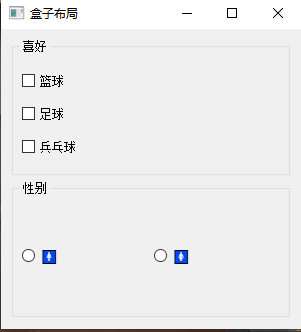
4.3 网格布局: QGridLayout
import sys
from PyQt5.QtWidgets import QWidget, QApplication, QVBoxLayout, QLineEdit, QGridLayout, QPushButton
class WL(QWidget):
def __init__(self):
super(WL, self).__init__()
self._init()
def _init(self):
"""设计内容"""
# 外部容器
outer = QVBoxLayout(self)
# 文本框
n = QLineEdit('输入数字:')
# 网格容器
g = QGridLayout()
# 数据处理
data = [
'1', '2', '3', '4', '5',
'6', '7', '8', '9', '0',
'(', ')', '+', '-', '*',
'/', 'C', '.', '=', '>'
]
for i, d in enumerate(data):
bt = QPushButton(d)
g.addWidget(bt, i//5, i % 5) # 行 列
# 添加控件&容器
outer.addWidget(n)
outer.addLayout(g)
if __name__ == '__main__':
app = QApplication(sys.argv)
w = WL()
w.show()
app.exec()
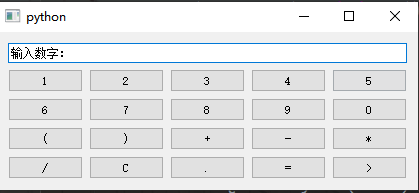
# coding=utf-8
from PyQt5.QtWidgets import QWidget, QVBoxLayout, QFormLayout, QPushButton, QApplication, QLineEdit, QCheckBox, \
QHBoxLayout
class Fq(QWidget):
def __init__(self):
super(Fq, self).__init__()
# 外部垂直容器
outer = QVBoxLayout(self)
# 表单容器
f = QFormLayout()
# 控件
user = QLineEdit()
psw = QLineEdit()
user.setPlaceholderText('请输入账号') # 设置输入框显示内容
psw.setPlaceholderText('请输入密码')
psw.setEchoMode(QLineEdit.Password) # 设置密码不可见
f.addRow('账号:', user)
f.addRow('密码:', psw)
bc = QCheckBox('下次自动登录')
# 添加内部水平容器
inner = QHBoxLayout()
bt = QPushButton('登录')
bz = QPushButton('重置')
bt.setFixedSize(120, 20)
bz.setFixedSize(120, 20)
# 初始化控件&容器
outer.addLayout(f)
outer.addWidget(bc)
inner.addWidget(bt)
inner.addWidget(bz)
outer.addLayout(inner)
outer.addStretch(1) # 设置控件拉伸间距
if __name__ == '__main__':
app = QApplication([])
w = Fq()
w.show()
app.exec()
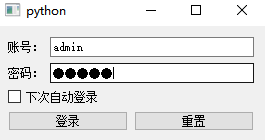
4.5 多页面切换布局: QStackedLayout
from PyQt5.QtWidgets import *
from PyQt5.QtCore import *
class W(QWidget):
def __init__(self):
super(W, self).__init__()
# 布局
sl = QStackedLayout(self)
# 控件
sl.addWidget(QLabel('测试文本1'))
sl.addWidget(QLabel('测试文本2'))
sl.addWidget(QLabel('测试文本3'))
sl.addWidget(QLabel('测试文本4'))
# 循环计时切换
t = QTimer(self)
t.timeout.connect(lambda: sl.setCurrentIndex((sl.currentIndex() + 1) % sl.count()))
t.start(1000)
if __name__ == '__main__':
app = QApplication([])
w = W()
w.show()
app.exec()
5. 信号 &槽
5.1 信号 => js事件 || 槽 => 事件处理方法(函数)
5.2 使用
import sys
from PyQt5.QtWidgets import *
class Signal(QWidget):
def __init__(self):
super(Signal, self).__init__()
# 添加控件
bt = QPushButton('点击一下', self)
# 绑定槽函数
bt.clicked.connect(self.handle)
def handle(self):
"""
槽函数的参数
取决于信号参数clicked(args,)
"""
print('按钮点击触发......')
if __name__ == '__main__':
app = QApplication(sys.argv)
w = Signal()
w.show()
app.exec()
5.3 自定义信号
import sys
from PyQt5.QtWidgets import *
from PyQt5.QtCore import *
class ISignal(QWidget):
# 添加信号
signal = pyqtSignal(str) # 可携带参数
def __init__(self):
"""自定义信号"""
super(ISignal, self).__init__()
# 绑定信号和槽
self.signal.connect(self.data)
# 控件
bt = QPushButton('点击一下', self)
# 控件绑定槽函数
bt.clicked.connect(self.click)
def click(self):
# 触发信号
self.signal.emit('你好呀!!!')
@staticmethod
def data(d):
print('点击事件完成\n信号传递的数据:', d)
if __name__ == '__main__':
app = QApplication(sys.argv)
w = ISignal()
w.show()
app.exec()












 浙公网安备 33010602011771号
浙公网安备 33010602011771号